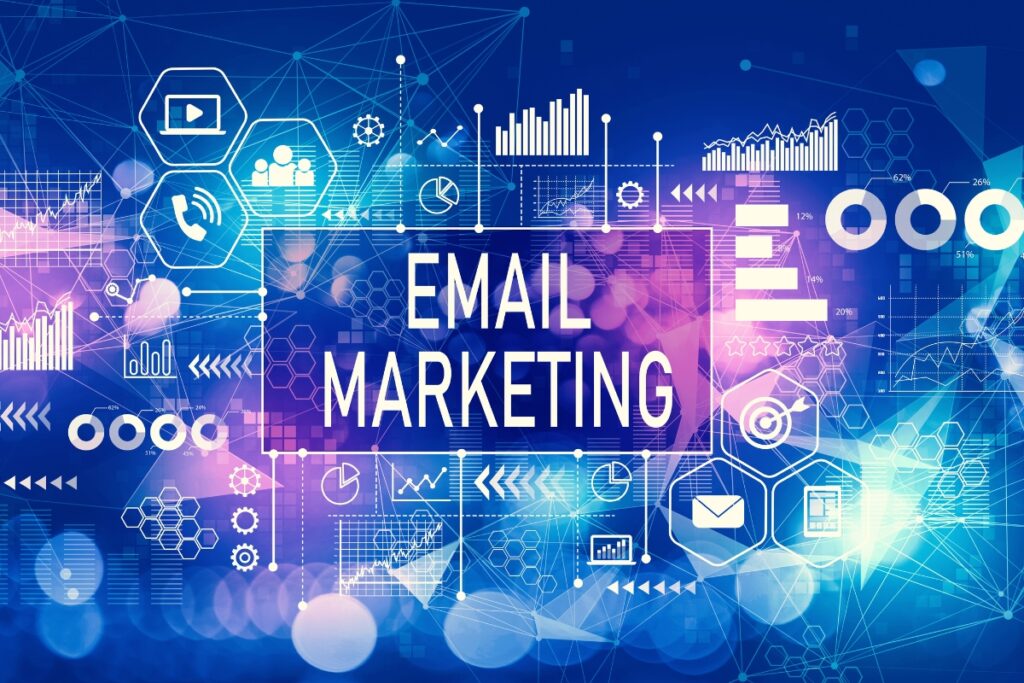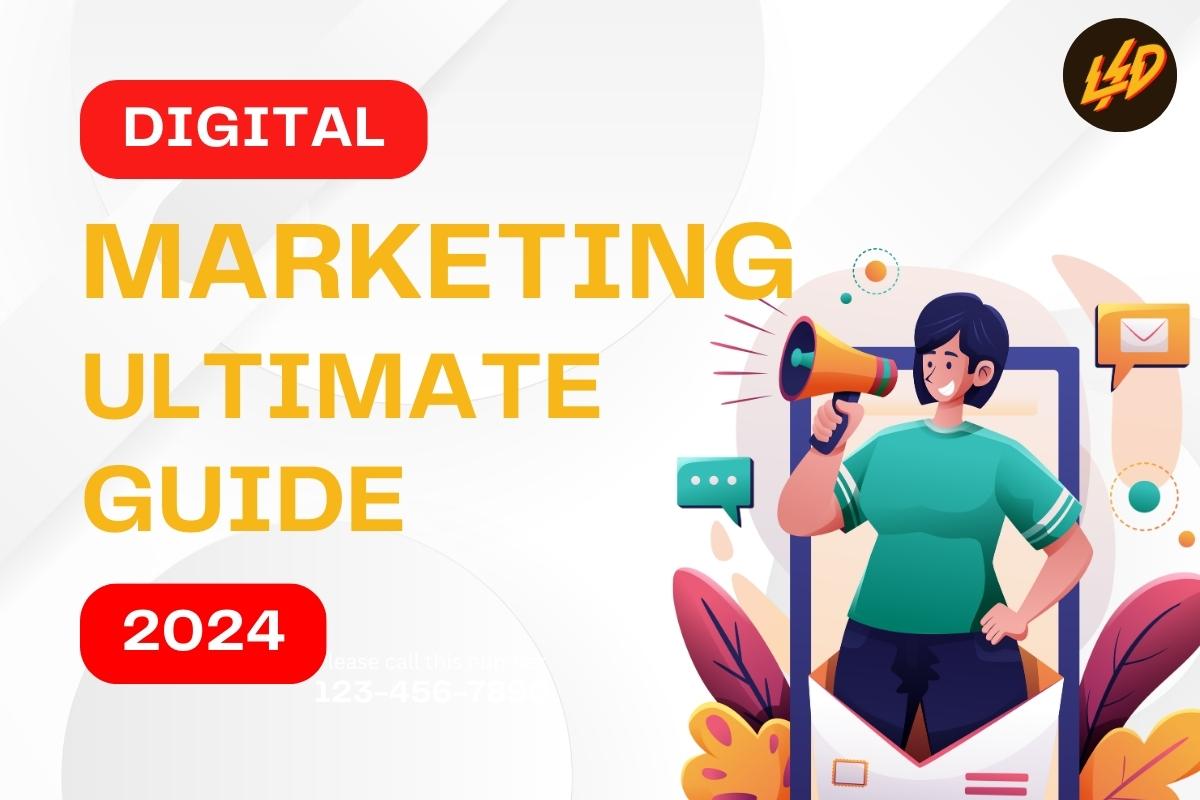In the world of digital marketing, staying ahead of the curve is crucial. As technology evolves and consumer behaviors shift, businesses need to adapt their strategies to remain competitive. In this blog post, we’ll explore the latest digital marketing trends that are shaping the industry globally. Whether you’re a small business owner, digital marketer, content creator, or SEO specialist, this overview will provide valuable insights to drive your marketing efforts forward.
1. What Is SEO?
SEO or Search Engine Optimization is a digital marketing strategy aimed at improving a website’s visibility on search engine results pages (SERPs). It involves various techniques and practices designed to make a website more attractive to search engines, thereby earning higher rankings for relevant keywords. As a result, a well-optimized website tends to attract more organic (non-paid) traffic. SEO encompasses several components, including keyword research, on-page optimization (like title tags, meta descriptions, and content), off-page optimization (such as backlinks), and technical SEO (like website speed and mobile-friendliness). By employing effective SEO strategies, businesses can increase their online visibility, reach their target audience more effectively, and enhance their potential for online growth.

SEO Updates
Search engine optimization (SEO) continues to be a cornerstone of digital marketing. Staying updated with the latest algorithm changes is vital for maintaining search rankings and visibility. Key areas to focus on include:
- Mobile Optimization: With the rise of mobile usage, optimizing your website for mobile devices is essential for a seamless user experience.
- Voice Search and Featured Snippets: Optimizing your content for voice search and aiming for featured snippets can help your website stand out in search results.
SEO Benefits for Sales
Search Engine Optimization (SEO) is a powerful tool that can significantly impact your sales figures. It is not just about attracting traffic to your website, but about attracting the right kind of traffic that is more likely to convert into sales.
- Improved Visibility: Effective SEO practices help your website rank higher in search engine results, making your business more visible to potential customers. The higher your website ranks, the more likely it is to be discovered by potential buyers.
- Increased Credibility: Ranking high on search engine results pages can increase your business’s credibility. Customers often equate higher rankings with trustworthiness and reliability, thus increasing the chances of them making a purchase.
- Targeted Traffic: SEO allows you to target specific keywords related to your products or services. By doing so, you attract visitors who are actively searching for what your business offers, thus increasing the likelihood of converting these visitors into customers.
- Long-Term Benefits: Unlike paid advertising, the benefits of SEO are long-term. Once your website achieves a high ranking, it is likely to stay there for some time, continually driving traffic and potential sales.
- Better User Experience: SEO also involves improving the user experience on your website. A user-friendly website can keep visitors engaged for longer, increasing the chances of them making a purchase.
- Insight into Customer Behavior: SEO tools provide valuable insights into customer behavior, helping you understand what your customers are searching for and how they navigate your website. These insights can inform your marketing strategy and help you optimize your sales funnel.
Incorporating SEO into your marketing strategy can significantly enhance your sales and overall business performance. It’s a cost-effective way to attract quality traffic, build brand awareness, and ultimately drive conversions.
SEO Best Practices
To maximize the benefits of SEO, it is essential to follow the best practices in the industry. Here are some key SEO best practices to consider:
- Keyword Research: Understand what terms your audience is using to find your content. Use these insights to inform your keyword strategy.
- Content Quality: Create high-quality, engaging content that provides value to your users. Search engines reward content that is original, valuable, and relevant to the query.
- On-Page SEO: Ensure your titles, meta descriptions, and content include your target keywords. Also, use header tags and alt text for images.
- Mobile Optimization: With more users accessing the web via mobile, it’s crucial that your website is mobile-friendly. Google’s algorithm favors mobile-friendly sites.
- Site Speed: Page loading speed is a vital ranking factor. Optimize your site’s speed by compressing images, leveraging browser caching, and reducing redirects.
- Backlinks: Acquire backlinks from reputable websites. Backlinks are a significant ranking factor and can boost your site’s credibility.
- User Experience: Make your website user-friendly. A well-structured, easy-to-navigate site with clear calls to action can enhance user experience, leading to longer site visits and higher conversion rates.
- Regular Updates: Keep your content fresh and up to date. Regularly updating your content with new information can improve your site’s ranking.
- Use of Analytics: Use tools like Google Analytics to track your website’s performance. This can provide valuable insights into areas that need improvement.
Implementing these best practices can help your website rank higher in search engine results, attract more organic traffic, and ultimately increase conversions. It’s important to remember, however, that SEO is a long-term strategy and results may not be immediately visible. Patience, consistency, and adaptability to changes in search engine algorithms are key to SEO success.
Read More: How to Improve Your Website’s Ranking with Effective On-Page SEO?
Common SEO Mistakes to Avoid
While it’s essential to understand and implement SEO best practices, it’s equally important to be aware of common mistakes that can hurt your search engine rankings. Here are some common SEO mistakes to avoid:
- Neglecting Content Quality: Many businesses focus too much on cramming keywords into their content, sacrificing its quality and readability. Remember, your content should provide value to the reader, not just search engines.
- Ignoring Mobile Optimization: In today’s mobile-first world, ignoring mobile optimization can be a costly mistake. A site that doesn’t render properly on mobile devices can drive away potential traffic.
- Slow Website Speed: A slow-loading website not only frustrates users but also negatively impacts your search engine rankings. It’s crucial to regularly check and optimize your site’s loading speed.
- Poor Keyword Selection: Choosing the wrong keywords can attract the wrong audience and result in low conversion rates. Make sure to conduct thorough keyword research to understand what terms your target audience is using.
- Inconsistent Content Updates: SEO isn’t a one-time task. Search engines favor sites that regularly update their content. Failing to regularly update your site can result in a drop in your search engine rankings.
- Ignoring Local SEO: If you have a brick-and-mortar store or serve a specific geographical area, ignoring local SEO can be a significant error. Local SEO can help your business appear in local search results, attracting more local customers.
- Overlooking Analytics: Ignoring SEO data and not using analytics tools can mean missing valuable insights into your website’s performance and areas that need improvement.
By avoiding these common mistakes, you can optimize your SEO strategy, improve your search engine rankings, and drive more organic traffic to your site.
Advantages of SEO
SEO, or Search Engine Optimization, is a crucial digital marketing strategy. It involves optimizing your website to rank higher on search engines, improving your visibility and leading to increased organic traffic. SEO also enhances user experience, making it easier for visitors to navigate your site and find what they’re looking for. Furthermore, SEO is a cost-effective strategy, as it targets users actively searching for your products or services online.
2. What Is Social Media Algorithms?
Social media algorithms are complex sets of rules and protocols used by social networking platforms to determine what content is displayed to users and in what order. These algorithms take into account various factors, such as the relevance of the content, the relationship between the user and the content creator, and the timing of the post. They are designed to provide a personalized user experience, showing content that the algorithm believes the user will find most appealing or engaging. Understanding these algorithms is crucial for businesses and marketers as they can significantly impact a brand’s visibility and engagement on social media platforms.

Social Media Algorithms
Social media algorithms play a significant role in determining the reach and engagement of your content. It’s essential to keep up with the latest algorithm updates and adjust your strategies accordingly. Consider the following trends:
- Changes in Algorithms: Stay informed about the latest changes on platforms like Facebook, Instagram, and Twitter, and adapt your approach to maximize organic reach.
- Video Content and Live Streaming: Leverage the power of video content and live streaming to engage your audience and boost visibility.
Understanding Social Media Algorithms
Social media algorithms are intricate systems used by platforms like Facebook, Instagram, Twitter, and LinkedIn to curate and present content to their users. They analyse numerous signals and data points, such as the type of content you engage with, the accounts you interact with most, and your typical usage patterns, to provide a personalized feed.
- Facebook’s Algorithm: Facebook primarily prioritizes content from family and friends. It places a strong emphasis on meaningful interactions, which include actions like commenting and sharing. Facebook also considers the relevance of the content, the reliability of the source, and the timeliness of the post.
- Instagram’s Algorithm: On Instagram, the algorithm’s priority is to show you content that you care about. It considers factors like the amount of time you spend on a post, your relationship with the person posting, and the timeliness of the post.
- Twitter’s Algorithm: Twitter uses its algorithm to show you a mix of tweets you are likely to find interesting. It considers factors like the tweet’s relevance to you, the tweet’s popularity, and your past interaction with the user tweeting.
- LinkedIn’s Algorithm: LinkedIn’s algorithm prioritizes content that is relevant to your professional interests. It values engagement, relevance, and relationships when determining what content to show.
- Pinterest’s Algorithm: Pinterest, a popular visual discovery engine, uses its sophisticated algorithm primarily to understand user behavior and preferences. It considers factors like the relevancy of a pin, user interaction with the pin, and the quality of the pin and the pinner. The algorithm also takes into account the freshness of a pin, with recent content often given priority. Understanding how Pinterest’s algorithm works can significantly enhance the effectiveness of your Pinterest marketing strategies.
Understanding these social media algorithms is crucial for businesses and marketers looking to increase their online presence. By tailoring their content strategy to the algorithms’ preferences, they can boost their visibility, improve their engagement rates, and strengthen their connections with their target audience.
Advantages of Social Media Algorithm
Social media algorithms play a vital role in content visibility and reach. These algorithms analyze user behavior to provide personalized content, enhancing user engagement. By understanding these algorithms, businesses can tailor their content and posting strategies to maximize visibility and engagement. Additionally, these algorithms can help businesses target their advertising efforts more effectively, reaching a more relevant audience.
3. What Is Content Marketing?
Content marketing is a strategic marketing approach centered on creating, distributing, and promoting valuable, relevant, and consistent content to attract and retain a clearly defined audience. Unlike traditional marketing strategies that focus on pitching products or services, content marketing is about providing useful information that solves problems, educates, entertains, or inspires to build a strong relationship with the audience. This approach helps businesses to position themselves as industry thought leaders, improve brand awareness, generate leads, and enhance customer loyalty. The types of content utilized in content marketing can range from blogs, articles, infographics, videos, podcasts, social media posts, to ebooks among others. The key to successful content marketing is understanding the needs and interests of the audience and creating content that addresses those needs and interests, thereby establishing your brand as a trusted resource.

Content Marketing Strategies
Content marketing remains a vital component of any successful digital marketing strategy. To effectively engage your audience, consider these trends:
- User-Generated Content and Influencer Collaborations: Encourage your audience to create and share content related to your brand. Partnering with influencers can also amplify your reach.
- Interactive and Immersive Content Formats: Embrace interactive content formats such as quizzes, polls, and augmented reality experiences to captivate your audience.
- Personalization and Targeted Messaging: Tailor your content to specific segments of your audience, delivering personalized experiences that resonate with them.
Effective Strategies for Content Marketing
Content marketing is a strategic approach focused on creating and distributing valuable, relevant, and consistent content to attract and retain a clearly defined audience. It aims to drive profitable customer action and is an essential part of modern digital marketing strategies. Here are some common content marketing strategies and their benefits:
- Blog Posting: Regularly updating a blog with fresh, relevant content is a great way to improve your site’s SEO, establish your business as an industry expert, and provide value to your audience. Blogs are versatile and can cover a range of topics, from industry news to how-to guides.
- Ebooks and Whitepapers: Ebooks and whitepapers provide detailed insights into specific topics. They are often used as opt-in incentives, helping to generate leads and gather valuable customer data.
- Infographics: Infographics are a visually engaging way to present complex information. They are highly shareable and can help boost brand awareness and recall.
- Social Media Content: Sharing content on social media platforms helps to increase visibility, engage with your audience, and drive traffic to your website. Each platform has its own unique characteristics, so it’s essential to tailor your content accordingly.
- Videos: Videos are incredibly engaging and can be used to explain complex ideas, showcase products, or tell brand stories. They are particularly effective on social media and can significantly increase engagement rates.
- Podcasts: Podcasts are a growing medium that allows businesses to connect with their audience on a more personal level. They are especially useful for sharing expert knowledge and insights, storytelling, and building brand loyalty.
Implementing these content marketing strategies can help to boost SEO, engage your audience, generate leads, and establish your business as an industry expert. By understanding your audience and creating content that provides value, you can create an effective content marketing strategy that drives profitable customer action.
Tips for Optimizing Social Media Content
Optimizing social media content can significantly boost your visibility, engagement rates, and connections with your audience. Here are some tips to optimize your content effectively:
- Understand Your Audience: Know who your target audience is and what type of content they engage with most. Use tools like Facebook Insights or Twitter Analytics to gain insights into your audience’s demographics, interests, and online behaviors.
- Create High-Quality Content: Develop engaging, relevant, and valuable content that your audience will want to share. Whether it’s a blog post, infographic, or video, ensure your content is high-quality and provides value to your audience.
- Optimize for Each Platform: Each social media platform has its own unique characteristics and audience expectations. Tailor your content to fit the specific platform where it will be shared.
- Use Relevant Hashtags: Hashtags can increase the visibility of your posts. Use relevant and trending hashtags to reach a larger audience.
- Engage with Your Audience: Social media is about two-way communication. Respond to comments, answer questions, and engage with your audience to build relationships and foster engagement.
- Analyze and Adapt: Regularly review your social media analytics to understand what’s working and what’s not. Use this data to refine your strategy and make necessary adjustments.
By implementing these tips, you can optimize your social media content and create a more effective social media marketing strategy.
Advantages of Content Marketing
Content marketing focuses on creating and distributing valuable and relevant content to attract and retain an audience. This strategy helps establish your brand as an authoritative voice in your industry, building trust and credibility. Content marketing also aids in SEO efforts, with quality content driving organic traffic and improving search engine rankings. Additionally, content marketing is effective for lead generation, with valuable content serving as an incentive for users to provide their contact information.
Read More: Best Digital Marketing Strategies for Small Businesses
4. What is Email Marketing?
Email marketing is a form of digital marketing that involves sending a commercial message, typically to a group of people, using email. It encompasses every email sent to a potential or current customer and is used to send advertisements, request business, or solicit sales or donations. Email marketing strategies commonly seek to achieve one or more of three primary objectives: enhance customer loyalty, boost brand awareness, or improve sales. Emails are often used to direct people towards the company’s website, and regular updates about the business, products, or services can keep customers engaged while boosting sales. The success of email marketing is predominantly driven by the relevancy of the content to the recipients; hence, efficient targeting and personalization strategies are crucial.

Email Marketing Automation
Email marketing automation allows you to streamline your communication efforts and deliver personalized messages at scale. Key trends in this area include:
- Behavioral Targeting and Segmentation: Segment your email list based on user behavior and preferences to deliver relevant content and offers.
- Drip Campaigns and Personalized Email Sequences: Automate email sequences that guide users through their customer journey, delivering timely and targeted messages.
- Integration with CRM Systems and Analytics: Integrate your email marketing platform with customer relationship management (CRM) systems to track and analyze the effectiveness of your campaigns.
Benefits of Email Marketing Automation
Email marketing automation stands as a game-changer in the realm of digital marketing, bringing several benefits that can greatly enhance your marketing efforts.
- Efficiency: Automation reduces the time and effort required to manage email campaigns, freeing up resources that can be allocated to other areas of your marketing strategy.
- Personalization: Automated systems can tailor emails to individual recipients based on their preferences and behaviors, delivering a personalized experience that can significantly increase engagement and conversion rates.
- Consistency: Automation ensures regular and consistent communication with your audience, keeping your brand at the top of their minds.
- Scalability: As your business grows, email marketing automation can effortlessly scale to handle larger audiences and more complex campaigns.
- Improved Customer Journey: Automated email sequences can guide users through the customer journey, from awareness to conversion, improving customer retention and loyalty.
- Metrics and Analytics: Most email marketing automation tools offer robust analytics, giving you insights into open rates, click-through rates, conversions, and other key metrics that can help optimize your strategies.
In essence, email marketing automation delivers greater efficiency, personalization, and effectiveness in your digital marketing efforts, driving better outcomes and ultimately, return on investment.
Challenges of Email Marketing Automation
While email marketing automation presents numerous benefits, it is not without its share of challenges. Navigating these can be the key to realizing the full potential of this powerful marketing tool.
- Data Management: Effective email automation requires clean, updated, and well-segmented data. Managing and maintaining this data can be challenging, particularly for businesses with large customer bases.
- Spam Filters: Automated emails, especially those with promotional content, are at a higher risk of getting flagged by spam filters. This can significantly reduce your email deliverability rates and engagement.
- Lack of Personalization: While automation tools offer personalization options, striking the right balance between automation and personal touch can be difficult. Over-reliance on automation can make emails feel impersonal and generic.
- Technical Issues: Implementing and managing email automation platforms may involve complex technical aspects, which can be daunting for businesses without sufficient expertise in this area.
- Regulatory Compliance: Compliance with data protection regulations like GDPR is a challenge. Businesses need to ensure they are not breaching any laws when sending automated emails.
In spite of these challenges, email marketing automation remains a valuable strategy when implemented effectively. It’s crucial to consistently review and refine your approach to overcome these hurdles and ensure your campaigns deliver the desired results.
Strategies to Overcome Email Marketing Automation Challenges
To realize the full potential of email marketing automation, businesses need to adopt effective strategies to navigate its challenges.
- Data Management: Employ data cleansing practices to maintain up-to-date and relevant customer data. Regularly segment and update your email lists based on consumer behavior, preferences, and engagement levels.
- Spam Filters: To avoid your emails landing in spam folders, ensure your content is valuable and relevant. Avoid spam trigger words in your subject lines and ensure your email is compliant with CAN-SPAM Act regulations.
- Personalization: Strike a balance between automation and personalization. Use automation tools to personalize emails based on customer data and interactions. However, keep a human touch in your messages to avoid sounding robotic.
- Technical Issues: Invest in training your team to handle the technical aspect of email automation platforms. Alternatively, consider hiring experts or outsourcing to a digital marketing agency.
- Regulatory Compliance: Stay updated with the latest changes in data protection laws and ensure your marketing practices are compliant. Use double opt-in methods to get explicit consent from subscribers and provide clear unsubscribe options in your emails.
By effectively addressing these challenges, businesses can maximize their email marketing automation efforts and ultimately enhance their marketing outcomes significantly.
Email Marketing Automation Best Practices
To further amplify your email marketing automation success, consider the following best practices:
- Set Clear Goals: Defining your objectives at the start will give your campaigns a clear direction and help you measure success.
- Segment Your Audience: Craft more effective messages by dividing your audience into segments based on their behavior, demographics, or other parameters.
- Test and Optimize: Test different aspects of your email, such as subject lines, content, and send times. Use these insights to continuously optimize your campaigns.
- Improve Email Deliverability: Regularly clean your email list, authenticate your email domain, and maintain a good sender reputation to improve your deliverability.
- Maintain a Steady Frequency: Sending too many emails can lead to unsubscribed too few may result in lost opportunities. Find a balance that keeps your audience engaged without overwhelming them., while sending
- Track and Analyze Metrics: Monitor key metrics like open rates, click-through rates, and conversions to gain insights and refine your strategies.
- Use a Welcome Series: A well-crafted welcome series boosts engagement, nurtures relationships, and helps new subscribers get to know your brand.
- Personalize Your Emails: Personalization goes beyond using the recipient’s name. Tailor the email content based on the recipient’s past behavior, preferences, and other personalized parameters.
- Ensure Mobile Optimization: With the majority of emails now opened on mobile devices, ensure your emails are mobile-friendly.
By implementing these best practices, you can enhance the effectiveness of your email marketing automation, providing a more personalized customer experience and leading to better marketing outcomes.
Advantages of Email Marketing
Email marketing is a highly effective digital marketing strategy that involves sending emails to prospects and customers. It allows for direct, personal communication with your audience, fostering strong customer relationships. Email marketing is also cost-effective, offering a high return on investment compared to other marketing strategies. Additionally, it’s easy to segment email lists based on various factors, allowing for highly targeted marketing campaigns.
5. What Is Influencer Marketing?
Influ?encer marketing is a type of social media marketing that leverages endorsements and product mentions from influencers–individuals who possess a dedicated social following and are viewed as experts within their niche. This form of marketing works because of the high amount of trust that influencers have built with their audience, and recommendations from them serve as a form of social proof to potential customers.

Influencer Marketing Trends
Influencer marketing continues to be a powerful strategy for reaching and engaging target audiences. Stay up to date with these trends:
- Micro and Nano-Influencers: Collaborate with influencers who have smaller but highly engaged followings, allowing for authentic connections with your audience.
- Authenticity and Transparency: Consumers value authenticity, so prioritize partnerships with influencers who align with your brand’s values and encourage transparent relationships.
- Measuring ROI and Tracking Campaign Success: Establish clear goals for your influencer campaigns and use analytics to track their success and return on investment (ROI).
The Power of Social Media Influencers
In the digital age, social media influencers have emerged as a potent force in shaping consumer behavior and preferences. With their large follower bases, influencers have the ability to reach a wide audience, making them a valuable asset for brands and marketers.
Influencer marketing, when executed rightly, can yield remarkable results. Collaborations with influencers can boost brand visibility, increase customer engagement, and drive conversion rates. This is primarily because influencers have earned the trust and admiration of their followers, who often look up to them for recommendations and advice.
In addition, influencers can enhance brand authenticity – a trait highly valued by today’s consumers. When an influencer genuinely resonates with a brand and its values, their endorsements come across as more believable and less “salesy”. This authenticity can significantly enhance brand image and credibility.
However, the success of influencer marketing heavily relies on choosing the right influencers that align well with your brand, and measuring the effectiveness of your campaigns. It is essential to set clear objectives, establish metrics, and use analytics to track performance and ROI.
In summary, social media influencers are transforming the marketing landscape and providing new avenues for brands to connect with consumers in a more personal and authentic way. As this trend continues to evolve, it’s clear that influencers will remain a key component in the digital marketing mix.
Benefits of Social Media Influencers
Leveraging social media influencers is a powerful marketing strategy that comes with several benefits. Firstly, influencers have an established audience with a high level of trust and credibility. Collaborating with them can provide access to this audience, increasing brand exposure. Influencers can also enhance brand authenticity as their endorsements often come across as more genuine to their followers. They create high-quality, engaging content, which can improve the brand’s content strategy. Additionally, influencer marketing can yield significant returns on investment, making it a cost-effective marketing strategy. Finally, influencers can help a brand tap into new markets, reach targeted audiences, and drive conversions more effectively than traditional advertising.
Advantages of Influencer Marketing
Influencer marketing offers several benefits for brands and businesses. First, it allows brands to reach their target audience in an authentic and organic way, as influencers have already established trust and credibility with their followers. Second, influencers’ content can boost a brand’s SEO by generating backlinks to the brand’s website. Third, influencer marketing can be a cost-effective method of advertising, as it can often generate a higher return on investment compared to other marketing strategies. Lastly, the unique and engaging content created by influencers can increase brand awareness and enhance customer loyalty, leading to higher conversion rates.
Conclusion
In the ever-changing digital marketing landscape, harnessing the power of content, email, and influencer marketing is of paramount importance. Each of these strategies offers unique benefits, from the capacity to establish strong customer relationships and generate targeted campaigns in email marketing, to the ability of content marketing to position your business as a trusted resource by addressing audience needs. Importantly, influencer marketing enables brands to authentically connect with audiences via trusted figures within their niche. As the digital sphere continues to evolve, these strategies will remain integral to successful marketing efforts, ultimately driving customer loyalty, brand awareness, and profitable customer action. It’s not just about reaching your audience; it’s about reaching them in the right way, with the right content, and at the right time.
View More: Freelance AI Jobs That Are in High Demand: Exciting Opportunities for Professionals
Frequently Asked Questions
1. What is the relevance of email marketing in 2024?
Email marketing remains a significant strategy in 2023/2024 as it provides a platform for personalized, direct communication with potential customers, leading to strengthened customer relationships and a high return on investment.
2. How has content marketing evolved in recent years?
Content marketing has continued to evolve, focusing more on providing value through educational, entertaining, or inspiring content that addresses the needs and interests of the audience. This strategy helps businesses position themselves as industry thought leaders and enhance customer loyalty.
3. How have influencers impacted the marketing landscape in 2023/2024?
Influencers have a profound impact on the marketing landscape, serving as a trusted link between brands and their target audience. Their endorsements act as social proof, increasing brand visibility, trust, and potentially leading to higher conversion rates.
4. What are the key elements of a successful email marketing campaign in 2023/2024?
The key elements of a successful email marketing campaign in 2023/2024 include personalization, relevancy of content, and efficient targeting strategies. Regular updates about the business, products, or services can also help keep customers engaged.
5. What types of content are most effective in content marketing in 2023/2024?
The effectiveness of content types varies based on audience preference. However, a mix of blogs, articles, infographics, videos, podcasts, social media posts, and ebooks remain relevant. The key is to understand the needs and interests of the audience and create content that addresses those needs.
6. How can businesses maximize the benefits of influencer marketing in 2023/2024?
Businesses can maximize the benefits of influencer marketing by partnering with influencers who have a strong alignment with their brand values and resonate with their target audience. It’s also important to ensure that influencer content aligns with the brand’s SEO strategy.
7. What are some potential drawbacks of email marketing?
While email marketing provides numerous benefits, it’s not without its challenges. Ineffective targeting may lead to low open rates and poor engagement. Additionally, the increasing prevalence of spam filters can result in emails not reaching the intended recipients’ inboxes. Too many promotional emails may also annoy customers, leading to unsubscribed.

